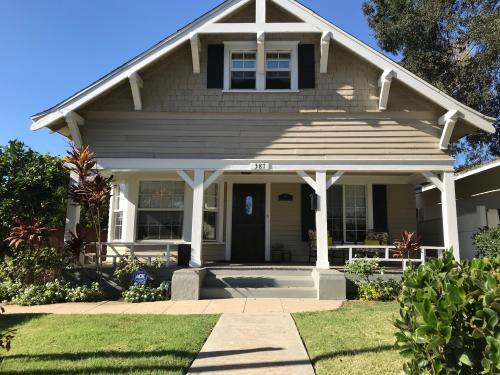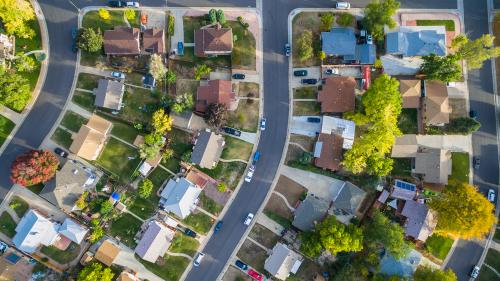In the decade since the financial crisis, nonbank mortgage companies—for example Quicken Loans, Inc., Freedom Mortgage Company, loanDepot.com, and Caliber Home Loans, Inc., just to name a few—have played a crucial role in maintaining access to mortgage credit.[1] Nonbanks originated about half of all mortgages in 2016, up sharply from 20 percent in 2007.
The share of mortgages issued by nonbanks grew, in part, because banks pulled back from extending mortgage credit to borrowers with lower credit scores in the aftermath of the financial crisis. Nonbanks may also have been quicker to take advantage of technological innovations in mortgage origination.
But as we describe in a paper published by Brookings Papers on Economic Activity, this growth also poses some risks to borrowers, communities, and the U.S. government. In particular, nonbanks are dependent on short-term credit to finance their operations, and this credit can become more expensive, or dry up entirely, when financial market conditions tighten. The business model of some nonbanks relies on mortgage refinancing; this revenue tends to diminish when interest rates rise. Nonbanks also, on average, service mortgages with a higher probability of default, so they are exposed to greater credit losses when house prices decline. As we describe in the paper, nonbank lenders that primarily originate mortgages insured by the Federal Housing Administration (FHA) or guaranteed by the Department of Veterans Affairs are particularly vulnerable to these strains.
Nonbank mortgage companies were hit hard during the financial crisis and many went out of business. The total number of mortgage companies (both independent and affiliated with banks) fell in half from 2006 to 2012—a drop of nearly 1,000 companies.
Suppose a shock of the magnitude of the financial crisis occurred today? In many ways, the mortgage market is more robust than a decade ago. Almost all securitization activity occurs currently through entities with government support, and underwriting reforms have improved mortgage credit quality. However, nonbanks are as dependent on short-term credit now as they were before the financial crisis, and the nonbank mortgage sector—especially for mortgages insured or guaranteed by FHA or VA—is substantially larger than it was in 2007. These facts suggest that the nonbank mortgage sector remains vulnerable to a significant and sustained macroeconomic shock.
If the sector contracts as it did in the financial crisis, the federal government, borrowers, and communities would likely be most affected. In the process of following through on its guarantees on the mortgages and on the securities that fund them, the federal government may incur losses. Although the mortgage servicing sector is in better shape than it was before the financial crisis, borrowers could still be harmed as a result of disorderly servicing transfer when a servicer fails. Meanwhile, a reduction in nonbanks could also reduce access to credit if other financial institutions do not step in to extend mortgage credit at similar terms. If the reduction in access to credit was large enough, it might have feedback effects into house prices.
These effects would be experienced more strongly in some communities than others. To help individuals gauge the extent to which their community might be affected, the interactive map below shows the share of mortgages in each county in 2016 that was originated by nonbank lenders and insured by the FHA or guaranteed by the VA (for convenience, denoted “nonbank FHA/VA share” from here on). The share is displayed only for urban counties, because the data source—data collected under the Home Mortgage Disclosure Act—is comprehensive only for these counties.
The map suggests that these types of mortgages are more prevalent in counties in parts of the southern and southwestern U.S. and in parts of Southern California. This geographic pattern probably reflects several factors. First, the VA mortgage guarantee is only available to borrowers who have served in the military, and large U.S. military bases are more likely to be located in these parts of the country. For example, the two counties in which Fort Bragg, a very large U.S. military installation, is located were ranked first and fourth among U.S. counties in 2016 by our measure: the nonbank FHA/VA share was 55 percent in Hoke County, North Carolina and 49 percent in Cumberland County, North Carolina. The third- and fifth-ranked counties by this measure are the locations of two other very large military installations, Camp Lejeune and Fort Hood.
Second, minorities are disproportionately likely to take out loans with FHA insurance or VA guarantees, and, even within this category, are more likely to have mortgages originated by nonbanks. Black Americans are a larger proportion of the population in the south than in other regions of the country, while the Hispanic population is a larger share of the population in the southern and western U.S.[2] Minorities are also more likely to be in the military and thus eligible for VA mortgage insurance.[3] The second-ranked county by our measure is Clayton County, Georgia, which is part of the Atlanta metro area and has a majority black population.
Third, house prices are generally lower in the south, and so most mortgage originations are smaller than the limits set by FHA, VA, Fannie Mae, and Freddie Mac for loans that they are willing to insure, guarantee, or acquire.[4] “Jumbo” loan originations that exceed these limits tend to be originated by banks, which can fund these loans with deposits and other sources unavailable to nonbanks. The easiest way to see the relationship between house prices and nonbank FHA/VA share is to look at the four lowest-ranked counties by this measure: New York County, New York (the location of Manhattan); San Francisco County, California; and two other counties in the immediate vicinity of San Francisco Bay area (San Mateo and Marin). In these four counties, the nonbank FHA/VA share was less than three percent in 2016.
The vulnerabilities nonbanks face are not necessarily an issue if nonbanks have the financial resources to withstand a shock, and if regulators have the information, tools, and authorities to spot issues early and resolve problems effectively. We suggest in the paper that there is room for improvement in both dimensions.
In the aggregate, nonbanks have a fairly low amount of unencumbered assets—that is, assets that are not currently used as collateral for a loan, and thus could be used to meet unexpected needs. Most nonbanks also do not have access to the government institutions, such as the Federal Reserve System or the Federal Home Loan Bank System, that provide short-term credit to depository institutions with liquidity needs. Meanwhile, the regulatory infrastructure for monitoring nonbanks for safety and soundness is less well-developed than the equivalent infrastructure for banks, and data on the financial condition of nonbanks are less standardized and are not widely available.
In response to these issues, Ginnie Mae recently unveiled an important set of proposals that would alleviate some of the liquidity strains that its issuers face; impose stronger leverage and financing standards on its issuers, as well as enhanced stress-testing exercises; improve Ginnie Mae’s ability to manage the failure of a large issuer; and require large issuers to obtain and maintain credit and servicer ratings from approved rating agencies.[5] This last proposal would increase the amount of information publicly available on the financial condition of large nonbank lenders. These steps, if implemented, would improve the resilience of the nonbank mortgage sector and reduce the risks to households and the government.
[1] These are the four nonbanks in the top ten mortgage lenders in 2016 as ranked by mortgage originations. See Table 11, “Top 25 respondents in terms of total originations, 2016,” Bhutta, Neil, Steven Laufer, and Daniel Ringo, Residential Mortgage Lending in 2016: Evidence from the Home Mortgage Disclosure Act Data, Federal Reserve Bulletin, 103(6): 2017 (November).
[2] See “The Black Population: 2010,” 2010 Census Briefs, available at https://www.census.gov/prod/cen2010/briefs/c2010br-06.pdf, and “The Hispanic Population: 2010,” 2010 Census Briefs, available at https://www.census.gov/prod/cen2010/briefs/c2010br-04.pdf.
[3] Office of the Under Secretary of Defense, Personnel and Readiness. Population Representation in the Military Services: Fiscal Year 2016 Summary Report. Published in 2018. Accessed September 3, 2018. http://www.cna.org/research/pop-rep.
[4] U.S. Census Bureau, “Median and Average Sales Price of Houses Sold by Region”, https://www.census.gov/construction/nrs/pdf/pricerega.pdf
[5] Ginnie Mae 2020: Roadmap for sustaining low-cost homeownership, June 2018, https://www.ginniemae.gov/newsroom/publications/Documents/ginniemae_2020.pdf
The authors did not receive financial support from any firm or person for this research or from any firm or person with a financial or political interest in this paper. They are currently not officers, directors,or board members of any organization with an interest in this paper. In order to ensure the confidentiality of individual banks, the Federal Reserve Board’s Division of Supervision and Regulation reviewed the relevant portions of this research before circulation. With the exception of the aforementioned, no outside party had the right to review this research before circulation. The views represented in this post are those of the authors and do not necessarily represent the views of the Board of Governors of the Federal Reserve System or its staff.










Commentary
Mapping the boom in nonbank mortgage lending—and understanding the risks
September 10, 2018